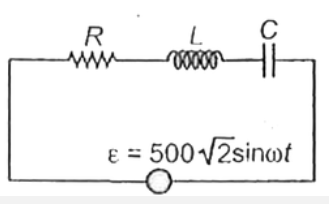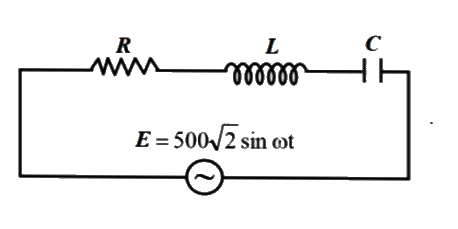In a series LCR the voltage across resistance, capacitance and inductance is 10V each. If the capacitance is shor t circulated, the voltage across the inducatance will be
10V
20V
The correct Answer is:A
To solve the problem step-by-step, we will analyze the situation in a series LCR circuit where the voltage across resistance (VR), capacitance (VC), and inductance (VL) is initially 10V each. We will then determine the voltage across the inductance when the capacitance is short-circuited.
1. Understanding the Initial Conditions:
- In a series LCR circuit, the voltage across each component (resistor, capacitor, and inductor) is given as 10V.
- Therefore, we have:
VR=VL=VC=10V
2. Applying the Phasor Relationship:
- In a series LCR circuit, the total voltage applied (V) can be expressed using the phasor relationship:
V=√V2R+(VL−VC)2
- Since VL and VC are equal (both are 10V), we can simplify this to:
V=√V2R+02=VR=10V
3. Short-Circuiting the Capacitance:
- When the capacitance is short-circuited, it effectively removes the capacitor from the circuit.
- The impedance of the circuit now consists only of the resistor (R) and the inductor (L).
4. Calculating the New Impedance:
- The new impedance (Z) of the circuit when the capacitor is short-circuited is given by:
Z=√R2+X2L
- Since VR=VL=10V, we can also say:
R=XL=10(since voltage across R and L are equal)
- Therefore, the new impedance becomes:
Z=√102+102=√200=10√2
5. Calculating the New Current:
- The new current (I') in the circuit can be calculated using Ohm's law:
I′=VZ=10V10√2=1√2A
6. Finding the Voltage Across the Inductor:
- The voltage across the inductor (V_L) can be calculated using:
VL=I′⋅XL
- Substituting the values:
VL=(1√2)⋅10=10√2V
Final Answer:
The voltage across the inductance when the capacitance is short-circuited is:
10√2V
- In a series LCR circuit, the voltage across each component (resistor, capacitor, and inductor) is given as 10V.
- Therefore, we have:
VR=VL=VC=10V
- In a series LCR circuit, the total voltage applied (V) can be expressed using the phasor relationship:
V=√V2R+(VL−VC)2
- Since VL and VC are equal (both are 10V), we can simplify this to:
V=√V2R+02=VR=10V
- When the capacitance is short-circuited, it effectively removes the capacitor from the circuit.
- The impedance of the circuit now consists only of the resistor (R) and the inductor (L).
- The new impedance (Z) of the circuit when the capacitor is short-circuited is given by:
Z=√R2+X2L
- Since VR=VL=10V, we can also say:
R=XL=10(since voltage across R and L are equal)
- Therefore, the new impedance becomes:
Z=√102+102=√200=10√2
- The new current (I') in the circuit can be calculated using Ohm's law:
I′=VZ=10V10√2=1√2A
- The voltage across the inductor (V_L) can be calculated using:
VL=I′⋅XL
- Substituting the values:
VL=(1√2)⋅10=10√2V
The voltage across the inductance when the capacitance is short-circuited is:
10√2V
Similar Questions
In a series L-C-R circuit the voltage across resistance , capacitance and inductance is 10 V each. If the capacitance is short circuited, the voltage across the inductance will be
View SolutionIn series LCR circuit voltage drop across resistance is 8V, across inductor is 6V and across capacitor is 12V. Then
View Solution
Knowledge Check
In a series LCR circuit, the voltage across the resistance, capacitance and inductance is 10 V each. If the capacitance is short circuited, the voltage across the inductance will be
A10VB10√2VC10√2VD20V
In a series LCR circuit the rms voltage across the inductance , capacitance and resistance are respectively 4 V, 8 V and 5 V . The RMS voltage of the AC source in the circuit is
View SolutionIn a series resonant circuit, the ac, voltage across resistance R, inductance L and capacitance are 5V, 10V and 10V, respectively. The ac. voltage applied to the circuit will be
View SolutionAn alternating voltage is connected in series with a resistance R and inductance L if the potential drop across the resistance is 200V and across the inductance is 150V, then the applied voltage is
View SolutionThree capacitors each of capacitance C and of breakdown voltage V are joined in series. The capacitance and breakdown voltage of the combination will be
View SolutionThe potential differences across the resistance, capacitance and inductance are 80V,40V and 100V respectively in an L−C−R circuit. The power factor of this circuit is
View SolutionIn a series RLC circuit the r.m.s. voltage across the resistor and the inductor are respectively 400 V and 700 V. If the equation for the applied Voltage is ε=500√2sinωt. then the peak voltage across the capacitor is

View SolutionIn the series L−C−R circuit shown in the figure, the rms voltage across the resistor and inductor are 400 V and 700 V respectively. If the applied voltage is E=500√2sin(ωt), then the peak voltage across the capacitor is

View Solution
